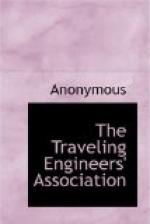A. As time is required to charge the auxiliaries, the feed groove in the triple valve being small, if the brakes are repeatedly applied and released without giving time to recharge, the braking power will be lost.
201. Q. What benefits are derived from the use of the retaining valve?
A. By use of the retaining valve the brake is held applied while the triple valve is in release position and the auxiliary is being recharged; thereby assisting in retarding the movement of the train down grade, also keeps the train bunched and gives a higher brake power on the second application with the same reduction of brake pipe pressure.
202. Q. With a seventy-pound brake pipe pressure how much of a reduction is necessary to set the brakes in full, and why?
A. About twenty pounds. This will cause the auxiliary reservoir and brake cylinder pressures to equalize.
203. Q. What effect has piston travel on the pressure developed in the brake cylinder?
A. The longer the piston travel the greater the volume or space to be filled with air; therefore the lower the pressure.
204. Q. When should brakes be tested?
A. Brakes should be tested before leaving a terminal and after any change in the make-up of the train, at all designated points, also, whenever the engineer is in doubt as to his having the control of all brakes.
205. Q. How should a terminal test of the brakes be made?
A. After the pressure is pumped up, a reduction of about ten pounds should be made and the length and force of the brake pipe exhaust should be noted, also the manner in which the exhaust closes; then a further reduction of ten pounds should be made and the brake held applied until signaled to release.
206. Q. If, when making a service application of the brake, the brake pipe exhaust closes suddenly and then begins to blow again, what does it indicate?
A. That the brakes, or at least part of them, have applied in quick action.
207. Q. What is meant by a running test, and when should this test be made?
A. A running test is made while the train is in motion, and steam is being used, when a sufficient reduction should be made to apply all brakes. After noting the efficiency of the brakes they should be released. Running tests should be made following all standing tests and at all other points on the road as required by the rules.
208. Q. When double-heading, which engineman should have full control of the brakes?
A. The head engineer; the cut-out cock under the brake valve on the second engine should be closed and the compressor allowed to run.
209. Q. How may the engineman assist the trainman in finding a bursted hose?
A. After the train has come to a stop, the brake valve should be placed in running position; by so doing, air will be admitted to the brake pipe and cause a blow at the point where the hose is burst.




